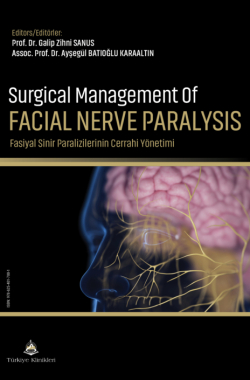Management of the Facial Nerve in Skull Base Surgery with Special Interest to Translabyrinthine Approach
Yıldırım Ahmet BAYAZITa
aİstanbul Medipol University Faculty of Medicine, Department of Otorhinolaryngology, İstanbul, Türkiye
Bayazıt YA. Management of the facial nerve in skull base surgery with special interest to translabyrinthine approach. In: Sanus GZ, Batıoğlu Karaaltın A, eds. Surgical Management of Facial Nerve Paralysis. 1st ed. Ankara: Türkiye Klinikleri; 2022. p.181-6.
ABSTRACT
Protection of the facial nerve is important in translabyrinthine surgeries as the nerve traverses throughout the surgical field. A thorugh knowledge of the surgical anatomy of facial nerve is essential in addition to microsurgical disection techniqeues. Although facial nerve monitoring has been a valuable tool in the protection of the facial nerve, the surgeron could evaluate the status of facial nerve which is exposed in the surgical field. Despite the nerve monitoring and precised microsurgical techniues, facial nerve paralyses at different severeties are possbile. It is important to differentiate neurotmesis from the axonotmesis and neuropraxia. In the cases of complete nerve sections, a number of reanimation techniques could be applied depending on the status of the patient and experience of the surgeon. A convervative management will allow for spontaneous revovery in cases of neuropraxia and axonotmesis.
Keywords: Facial nerve; facial nerve monitoring; translabyrinthine approach
Kaynak Göster
Referanslar
- Isaacson B, Kileny PR, El-Kashlan H, Gadre AK. Intraoperative monitoring and facial nerve outcomes after vestibular schwannoma resection. Otol Neurotol. 2003;24(5):812-7. [Crossref] [PubMed]
- Kircher ML, Kartush JM. Pitfalls in intraoperative nerve monitoring during vestibular schwannoma surgery. Neurosurg Focus. 2012;33(3):E5. [Crossref] [PubMed]
- Nakao Y, Piccirillo E, Falcioni M, Taibah A, Russo A, Kobayashi T, et al. Prediction of facial nerve outcome using electromyographic responses in acoustic neuroma surgery. Otol Neurotol 2002;23(1):93-5. [Crossref] [PubMed]
- Dandinarasaiah M, Prasad SC, Piccirillo E, Vashishth A, Valentina M, Grnibblat G, et al. Facial nerve outcomes following total excision of vestibular schwannoma by the enlarged translabyrinthine approach. Otol Neurotol. 2019;40(2):226-235. [Crossref] [PubMed]
- Rudman KL, Rhee JS. Habilitation of facial nerve dysfunction after resection of a vestibular schwannoma. Otolaryngol Clin North Am. 2012;45(2):513-30. [Crossref] [PubMed]
- Sanchez A, Pannu J, Fuller JC. Facial paralysis: timing of repair and management of the nonflaccidly paralyzed face. Curr Opin Otolaryngol Head Neck Surg. 2021;29(4):265-70. [Crossref] [PubMed]
- Catli T, Bayazit YA, Gokdogan O, Goksu N. Facial reanimation with end-toend hypoglossofacial anastomosis: 20 years' experience. J Laryngol Otol. 2010;124(1):23-5. [Crossref] [PubMed]
- Daeschler SC, Zuker R, Borschel GH. strategies to improve cross-face nerve grafting in facial paralysis. Facial Plast Surg Clin North Am. 2021;29(3):423- 30. [Crossref] [PubMed]
- Rammal A, Yoo J, Matic D. Static sling options for facial paralysis: now versus 10 years ago. Facial Plast Surg Clin North Am. 2021;29(3):375-81. [Crossref] [PubMed]

